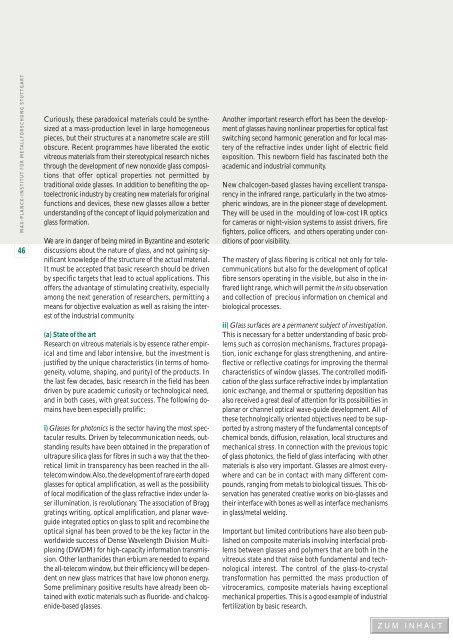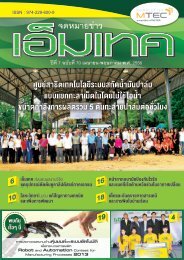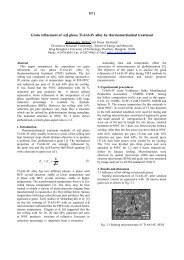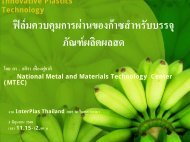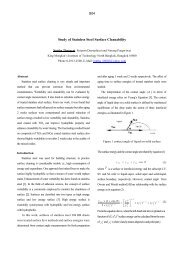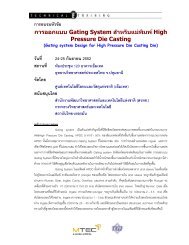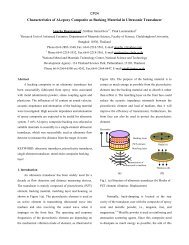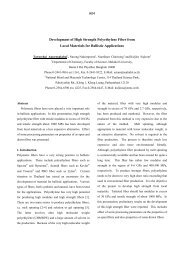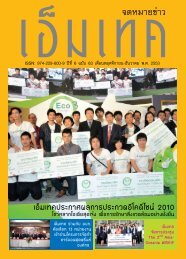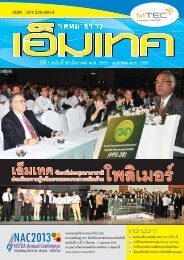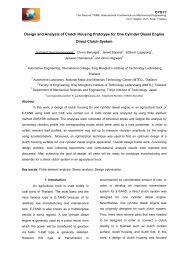EUROPEAN WHITE BOOK
EUROPEAN WHITE BOOK
EUROPEAN WHITE BOOK
You also want an ePaper? Increase the reach of your titles
YUMPU automatically turns print PDFs into web optimized ePapers that Google loves.
MAX-PLANCK-INSTITUT FÜR METALLFORSCHUNG STUTTGART46Curiously, these paradoxical materials could be synthesizedat a mass-production level in large homogeneouspieces, but their structures at a nanometre scale are stillobscure. Recent programmes have liberated the exoticvitreous materials from their stereotypical research nichesthrough the development of new nonoxide glass compositionsthat offer optical properties not permitted bytraditional oxide glasses. In addition to benefiting the optoelectronicindustry by creating new materials for originalfunctions and devices, these new glasses allow a betterunderstanding of the concept of liquid polymerization andglass formation.We are in danger of being mired in Byzantine and esotericdiscussions about the nature of glass, and not gaining significantknowledge of the structure of the actual material.It must be accepted that basic research should be drivenby specific targets that lead to actual applications. Thisoffers the advantage of stimulating creativity, especiallyamong the next generation of researchers, permitting ameans for objective evaluation as well as raising the interestof the industrial community.(a) State of the artResearch on vitreous materials is by essence rather empiricaland time and labor intensive, but the investment isjustified by the unique characteristics (in terms of homogeneity,volume, shaping, and purity) of the products. Inthe last few decades, basic research in the field has beendriven by pure academic curiosity or technological need,and in both cases, with great success. The following domainshave been especially prolific:i) Glasses for photonics is the sector having the most spectacularresults. Driven by telecommunication needs, outstandingresults have been obtained in the preparation ofultrapure silica glass for fibres in such a way that the theoreticallimit in transparency has been reached in the alltelecomwindow. Also, the development of rare earth dopedglasses for optical amplification, as well as the possibilityof local modification of the glass refractive index under laserillumination, is revolutionary. The association of Bragggratings writing, optical amplification, and planar waveguideintegrated optics on glass to split and recombine theoptical signal has been proved to be the key factor in theworldwide success of Dense Wavelength Division Multiplexing(DWDM) for high-capacity information transmission.Other lanthanides than erbium are needed to expandthe all-telecom window, but their efficiency will be dependenton new glass matrices that have low phonon energy.Some preliminary positive results have already been obtainedwith exotic materials such as fluoride- and chalcogenide-basedglasses.Another important research effort has been the developmentof glasses having nonlinear properties for optical fastswitching second harmonic generation and for local masteryof the refractive index under light of electric fieldexposition. This newborn field has fascinated both theacademic and industrial community.New chalcogen-based glasses having excellent transparencyin the infrared range, particularly in the two atmosphericwindows, are in the pioneer stage of development.They will be used in the moulding of low-cost IR opticsfor cameras or night-vision systems to assist drivers, firefighters, police officers, and others operating under conditionsof poor visibility.The mastery of glass fibering is critical not only for telecommunicationsbut also for the development of opticalfibre sensors operating in the visible, but also in the infraredlight range, which will permit the in situ observationand collection of precious information on chemical andbiological processes.ii) Glass surfaces are a permanent subject of investigation.This is necessary for a better understanding of basic problemssuch as corrosion mechanisms, fractures propagation,ionic exchange for glass strengthening, and antireflectiveor reflective coatings for improving the thermalcharacteristics of window glasses. The controlled modificationof the glass surface refractive index by implantationionic exchange, and thermal or sputtering deposition hasalso received a great deal of attention for its possibilities inplanar or channel optical wave-guide development. All ofthese technologically oriented objectives need to be supportedby a strong mastery of the fundamental concepts ofchemical bonds, diffusion, relaxation, local structures andmechanical stress. In connection with the previous topicof glass photonics, the field of glass interfacing with othermaterials is also very important. Glasses are almost everywhereand can be in contact with many different compounds,ranging from metals to biological tissues. This observationhas generated creative works on bio-glasses andtheir interface with bones as well as interface mechanismsin glass/metal welding.Important but limited contributions have also been publishedon composite materials involving interfacial problemsbetween glasses and polymers that are both in thevitreous state and that raise both fundamental and technologicalinterest. The control of the glass-to-crystaltransformation has permitted the mass production ofvitroceramics, composite materials having exceptionalmechanical properties. This is a good example of industrialfertilization by basic research.


